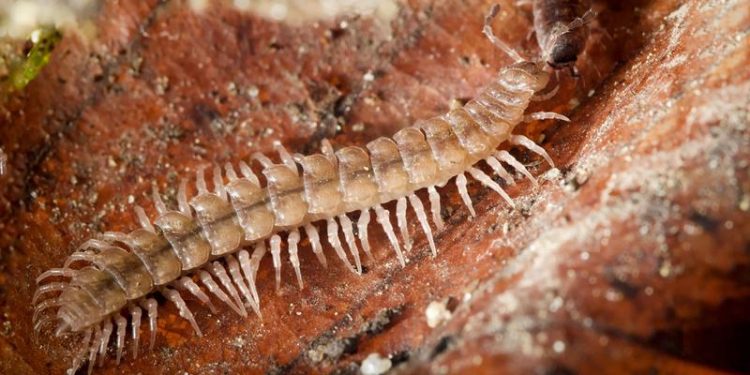Urban biodiversity: Remarkable diversity of small animals in Basel gardens

The millipede species “Polydesmus angustus” was found in several gardens. This species is mainly found in forests in the Basel region. Photo: University of Basel / Dr. José Gilgado
More and more people around the world live in cities. Accordingly, settlement areas are also rapidly increasing, often at the expense of near-natural habitats. So far, it has been widely assumed that the few green spaces remaining in cities can only accommodate a limited number of species.
The reason for this is the high proportion of sealed areas, which makes the exchange of small animals difficult or even impossible. In addition, cities have higher temperatures and less precipitation than rural areas.
However, even small and isolated green spaces can contribute to preserve biodiversity in built-up areas, as researchers from the Section of Conservation Biology at the University of Basel have shown in a large-scale field study.
Following a public call for participation, 35 garden owners from the Basel region made their green spaces available for the field investigation. At regular intervals in 2018, the researchers visited the gardens to determine the diversity of native plants and soil-dwelling animals.
Biodiversity measure: Flightless small animals
Biodiversity is often measured by the diversity of butterflies and wild bees. “But in the case of small-sized study areas such as gardens, flying animals could be only passing through,” says Prof. Bruno Baur.
“For this reason, we put our focus on soil-dwelling animals that are not capable of flying and that tend to have a cryptic life, such as ants, woodlice, beetles, snails, spiders, and millipedes.”
Typically, these small creatures are hardly noticed by garden owners, even though they fulfill important functions in the garden ecosystem.
“For example, spiders help to reduce pest insects; ants mix the soil and thus contribute significantly to soil aeration, while woodlice and millipedes are important for soil formation,” explains the conservation biologist.
First records for Switzerland
A total of 254 species were found in the 35 gardens, including 24 ants, 10 woodlice, 87 rove beetles, and 24 ground beetles, 39 snails, 52 spiders, and 18 millipedes. In addition to the expected widespread species, some rare species listed on the Swiss Red List of threatened species were also found. Noteworthy, furthermore, are the first records of four species of millipede species, which have not yet been found anywhere else in Switzerland.
Structural diversity of importance
With regard to the diversity of species found, there were major differences in the gardens studied. “We found that the structural diversity of the individual gardens is important, i.e., the combination of various microhabitats such as grassland, bushes, heaps of decaying leaves or deadwood,” explains the biologist Dr. Brigitte Braschler. “In most animal groups, the diversity of species increased with the structural diversity of the garden.”
The results of the study point to the great importance of small green spaces in urban areas; garden owners can directly promote biodiversity by actively increasing the structural diversity of their garden and thus make a sustainable contribution to urban biodiversity.
Dr. Brigitte Braschler, University of Basel, Department of Environmental Sciences, Section of Conservation Biology, phone +41 61 207 08 56, email: brigitte.braschler@unibas.ch
Prof. Dr. Bruno Baur, University of Basel, Department of Environmental Sciences, Section of Conservation Biology, phone +41 61 207 08 29, email: bruno.baur@unibas.ch
Media Contact
More Information:
http://www.unibas.chAll latest news from the category: Life Sciences and Chemistry
Articles and reports from the Life Sciences and chemistry area deal with applied and basic research into modern biology, chemistry and human medicine.
Valuable information can be found on a range of life sciences fields including bacteriology, biochemistry, bionics, bioinformatics, biophysics, biotechnology, genetics, geobotany, human biology, marine biology, microbiology, molecular biology, cellular biology, zoology, bioinorganic chemistry, microchemistry and environmental chemistry.
Newest articles

A new puzzle piece for string theory research
Dr. Ksenia Fedosova from the Cluster of Excellence Mathematics Münster, along with an international research team, has proven a conjecture in string theory that physicists had proposed regarding certain equations….

Climate change can cause stress in herring larvae
The occurrence of multiple stressors undermines the acclimatisation strategies of juvenile herring: If larvae are exposed to several stress factors at the same time, their ability to respond to these…

Making high-yielding rice affordable and sustainable
Plant biologists show how two genes work together to trigger embryo formation in rice. Rice is a staple food crop for more than half the world’s population, but most farmers…



